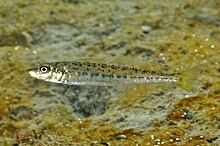| King George whiting | |
|---|---|

| |
| Juvenile | |
| Scientific classification | |
| Domain: | Eukaryota |
| Kingdom: | Animalia |
| Phylum: | Chordata |
| Class: | Actinopterygii |
| Order: | Spariformes |
| Family: | Sillaginidae |
| Genus: | Sillaginodes T. N. Gill, 1861 |
| Species: | S. punctatus
|
| Binomial name | |
| Sillaginodes punctatus (Cuvier, 1829)
| |

| |
| Range of the King George whiting | |
| Synonyms | |
| |
The King George whiting (Sillaginodes punctatus), also known as the spotted whiting or spotted sillago, is a coastal marine fish of the smelt-whitings family Sillaginidae. The King George whiting is endemic to Australia, inhabiting the south coast of the country from Jurien Bay, Western Australia to Botany Bay, New South Wales in the east.[1] The King George whiting is the only member of the genus Sillaginodes and the largest member of the smelt-whiting family Sillaginidae, growing to a length of 80 cm and 4.8 kg in weight. The species is readily distinguishable from other Australian whitings by its unique pattern of spots, as well as its highly elongate shape. King George whiting are often found in bays and protected waterways over sand and seagrass beds, also venturing out onto deep continental shelf reefs during adulthood. The species is a benthic carnivore, consuming a variety of crustaceans, polychaete worms, molluscs and fish. The King George whiting forms the basis of one of southern Australia's most important commercial fisheries, reportedly worth over five million Australian dollars per year. The species is also heavily targeted by recreational anglers, who value the whiting for its sporting and eating qualities.
- ^ Bray, D. "King George Whiting, Sillaginodes punctata". Fishes of Australia. Archived from the original on 11 March 2020. Retrieved 26 August 2014.